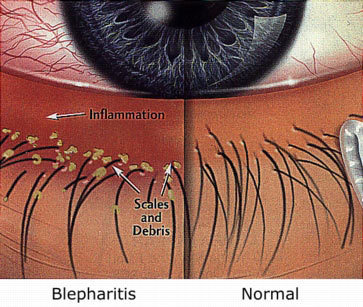What is BlephEx? A New Treatment for Blepharitis, the Most Common Eye Disease You Never Heard Of
 You may have critters living on your lashes and not know it. Or, you may have a condition called Blepharitis that makes your eyelashes more hospitable to those critters. Either way, wouldn’t you want to know?
You may have critters living on your lashes and not know it. Or, you may have a condition called Blepharitis that makes your eyelashes more hospitable to those critters. Either way, wouldn’t you want to know?
Insight Eyecare now offers detection and treatment of Blepharitis, as well as the parasitic mite called Demodex that tends to colonize infected lashes.
To be clear, we all have bacteria living on our eyelashes. That’s normal. But an overgrowth of these bacteria creates a biofilm that Dr. Pinkerton likens to plaque on your teeth. The buildup can cause all sorts of problems, from dryness and irritation to tear gland damage. It’s also a perfect food source for the Demodex mite, whose presence causes even more problems.
Though you’ve perhaps never heard of it, Blepharitis is one of the most common eye conditions seen by eye doctors and also one of the most undertreated due to the inefficacy of previous treatment options. But Blepharitis could very well be to blame if you suffer from dry, itchy eyes or the frequent sensation that there’s a foreign body in your eye. Left untreated, Blepharitis can lead to Dry Eye Disease, contact lens intolerance, and tear gland damage.
Evict Parasitic Eye Mites
Luckily, there’s a new technique for removing biofilm from the eyelid margin. Called microblepharoexfoliation (MBE), it’s a five- to 10-minute in-office procedure performed by Dr. Pinkerton using a handheld instrument called BlephEx. The device gently debrides and exfoliates the lid margins and unclogs glands. Although painless, the procedure can cause a tickling sensation from the vibration of the rotating tip, so a numbing drop is usually administered to ensure the treatment is well-tolerated. Patients often report immediate relief from symptoms and an eventual resumption of normal tear production.
All patients are seen for a follow-up visit to evaluate their post-procedural home care effectiveness and to make sure there are no Demodex hatchlings lurking on their lashes.
Keep Mites From Coming Back
Nightly home lid scrubs are recommended after MBE. Unfortunately for Blepharitis sufferers, the biofilm will accumulate again over time despite their best efforts; thus, repeat MBE treatments are prescribed every few months to keep Blepharitis and its bothersome symptoms at bay. Again, Dr. Pinkerton likens this ongoing at-home and in-office regimen to dental care to prevent the buildup of plaque. The nightly lid scrubs are sort of like daily flossing, and the MBE is like the regularly scheduled cleanings you get at the dentist even if you aren’t necessarily experiencing problems with your teeth. Though not curative, ongoing treatment is preventive, helping you avoid long-term inflammatory damage to your tear glands.
Additional Information
Insight Eyecare is among the first to offer BlephEx in East Texas. To learn more about how Blepharitis forms and affects your eyes, and the newest available treatment, watch this animated video.
To witness a real patient’s results, watch this newscast.
Comments are closed.

Why haven’t a billing code been made for Blephex Plus. I had the procedure done at eye doctor, but had to pay $195.00 . They said there was no billing code, so it couldn’t be sent to my insurance company
BlephEx is a relatively new, clinically proven treatment not yet covered by most insurance providers. Hopefully your eye care provider told you upfront that, for now, BlephEx is a private pay procedure.
Blephex is an effective treatment for blepharitis, dry eyes and many other eye problems. I was suffering from dry eye syndrome. My eyes was always dry after sleeping. Blephex helped me to getting rid of this problem.
[…] Eyelid exfoliation (BlephEx) […]